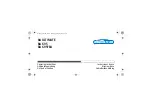
All those Trimmers
Before you use your 3031 in a real musical situation, you need to set up the presets or
trimmers. You will need a small precision screwdriver or a special trimmer adjustment tool.
The latter is very useful to have, and it also features a side wall to stop the screwdriver falling
out of place when you are adjusting the multiturn types.
The first one to set is the one marked
PSU
. This sets the output voltage of the 12 V regulator.
However, to set this one correctly you need to monitor the voltage at TP1. This is a special
pad near the top left hand of the PCB. Measure the voltage with respect to ground or the
GND pad. Turn PSU until the voltage is exactly 5.33V +/-20mV.
The
BAL
preset is adjusted with the use of an oscilloscope. If you don’t have a scope then set
it to the middle position. Set up your scope so that when both probes receive the same input
you get a straight line on the screen, i.e. add ch2 to ch1. Put one probe on the ‘+’ output, and
the other on the ‘-’ output. Now apply a CV and gate signal, or midi, and adjust BAL until the
scope no longer registers any output.
V/OCT:
Use this to generate a perfect 1V/octave scaling. This trimmer will need to be
adjusted along with the
TUNE
trimmer. You will need a scope, or a digital frequency counter,
or the best of all, a guitar/chromatic tuner. Some people use another keyboard or a calibrated
VCO and listen to the beats, but that can take longer.
Plug your midi-CV convertor or 1V/oct keyboard into the CV input of the 3031. Play a lowish
note on the keyboard, then go two octaves higher. Adjust V/OCT until the interval is
EXACTLY two octaves. This will probably require some patience and plenty of twiddling of
the front panel Tune as well. But you will get there. Now leave it on for one hour, and then
check the scaling. Adjust if necessary.
TUNE:
This sets the range over which your VCO acts. Set its final adjustment so that the
VCO is in tune perfectly when the front panel tune control is in its central position. Note that
changing the PSU trimmer will affect the tuning, so leave that well alone.
The
SENS
preset is sets the sensitivity of the velocity processor. Switch the velocity processor
on from the ‘velocity control’ switch, and adjust SENS so that you can get slide and accent to
engage when you hit the keys nice and hard. If you have a sequencer attached to the tbDAC,
then make sure velocity values of over 100 make both the accent and slide LEDs light up.
Adjust
TRIM
to suit your own taste. This one alters the sensitivity and range of the filters
frequency pot.
OFFSET
adjusts the VCA offset. Play a sequence into the 3031. Set the filter cut off
frequency quite low, and put the ‘amount’ and ‘modulation’ pots on their minimum setting.
Now adjust the OFFSET trimmer until the little clicks at the start of every note disappear.
They probably won’t go away completely, but you will be able to minimise them pretty well.
22
Summary of Contents for 3031 SuperBassLine
Page 24: ......



































